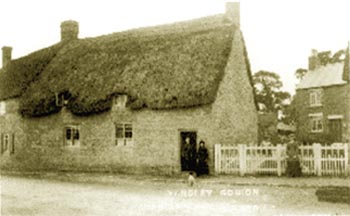Lottie Church nee Smith
The Village of Yardley Gobion in the 19th Century
Related to Doreen Covington by Mrs Church who died aged 87 years, transcribed 12th October 1984
I was born one Lottie Smith, nearly 85 years ago – the house is still standing, it is opposite the bus stop, it used to be thatched but now has a tiled roof .
I remember coming out of school (Now the Church Hall) and playing on the Green at the corner of Grafton Road where there was the village pump and a seat round the elm tree which grew in the middle. We used to sit on the seat from where we could watch the barges on the canal being drawn along by horses and sometimes stopping at the wharf which was then an off licence. There were three public houses – The Coffee Pot, the Pack Horse (Now a house painted blue and white at the corner of Grafton Road) and also the Red House, opposite the entrance to Yardley House. There were also three Butcher Shops, a Grocery and Drapers Shop in Moorend Road, 2 small Grocery shops, one on the bank looking down Grafton Road and the other next to the Red House pub – this was the larger shop and I thought it very important because I remember my father taking me there to buy extra groceries at Christmas time. The Post Office was in Moorend Road close to the pathway through to the new houses.. My great grandfather Mr Foddy was the village tailor and lived in the house on the corner next to the Coffee Pot.
To me then the village seemed very big although there was only one main street from Moor End farm to the Coffee Pot, there was Grafton Road, Botany Bay now called Chestnut Road and the workhouse now called Mount Pleasant.
We were very proud of our village band and our Morris Dancers who made May Day a day to look forward to and one each year to remember. The May Day celebration with all the dancing and crowning of the May Queen took place in Highcroft Field on which now stand the houses in Hesketh Road on the side of the New Vicarage.
Another day we looked forward to was Yardley Feast Day which was held on the Sunday following November 11th followed by a school holiday on the Monday and Tuesday which was a great time for the children and took the form of a village fair.
The Green on which now grow the chestnut trees used to be the saw pits where the menfolk used to saw logs they required and no doubt worked up a thirst to be quenched at the nearby Coffee Pot.
Much of the village belonged to the Duke of Grafton and a relative Fitzroy, used to live at Yardley House. There were a number of stone cottages along Moorend Road, a row opposite Kerry Farm and many each side nearer the village.
The only transport from the village was on a Saturday when a carriers van used to pick up anyone wishing to go to Northampton! The villagers had to walk into Stony Stratford, the menfolk cycled or walked along the canal bank to their work at Wolverton Works – most were either working on the land or at the Works.
I hope that I have portrayed to you a picture of the way of life in this village in 19th Century (In the Good Old, Bad old days!)
Details kindly given by Charlotte Church
Birthdate 1890 Taken from Yardley Gobion School Log Book.
Lottie 4th from left with friends celebrating
the Coronation of King George VI
Lottie Church with her young
family about 1921



